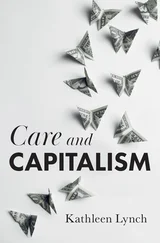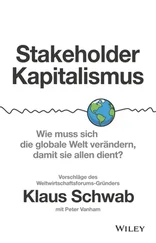Klaus Schwab - Stakeholder Capitalism
Здесь есть возможность читать онлайн «Klaus Schwab - Stakeholder Capitalism» — ознакомительный отрывок электронной книги совершенно бесплатно, а после прочтения отрывка купить полную версию. В некоторых случаях можно слушать аудио, скачать через торрент в формате fb2 и присутствует краткое содержание. ISBN: , Жанр: economics, на английском языке. Описание произведения, (предисловие) а так же отзывы посетителей доступны на портале библиотеки ЛибКат.
- Название:Stakeholder Capitalism
- Автор:
- Жанр:
- Год:неизвестен
- ISBN:9781119756149
- Рейтинг книги:4 / 5. Голосов: 1
-
Избранное:Добавить в избранное
- Отзывы:
-
Ваша оценка:
- 80
- 1
- 2
- 3
- 4
- 5
Stakeholder Capitalism: краткое содержание, описание и аннотация
Предлагаем к чтению аннотацию, описание, краткое содержание или предисловие (зависит от того, что написал сам автор книги «Stakeholder Capitalism»). Если вы не нашли необходимую информацию о книге — напишите в комментариях, мы постараемся отыскать её.
Individual agency:
A clearly defined social contract:
Planning for future generations:
Better measures of economic success: Stakeholder Capitalism: A Global Economy that Works for Progress, People and Planet
Stakeholder Capitalism
Stakeholder Capitalism — читать онлайн ознакомительный отрывок
Ниже представлен текст книги, разбитый по страницам. Система сохранения места последней прочитанной страницы, позволяет с удобством читать онлайн бесплатно книгу «Stakeholder Capitalism», без необходимости каждый раз заново искать на чём Вы остановились. Поставьте закладку, и сможете в любой момент перейти на страницу, на которой закончили чтение.
Интервал:
Закладка:
In Swabia, too, new technologies were implemented on the back of this economic miracle. At Ravensburger, for example, sales tripled in the 1950s, kicking off the phase of mass industrial production that began in 1962. Family board games like Rheinreise (which literally translates as “Journey on the Rhine”) became extremely popular 8 8 Company interview with Heinrich Huentelmann and Tristan Schwennsen, August 2019.
as the children of the baby boom came of age. Ravensburger expanded further in the 1960s, 9 9 Ravensburger, About Ravensburger, https://www.ravensburger-gruppe.de/en/about-ravensburger/company-history/index.html#1952-1979 .
when the company introduced puzzles to its product line. (The brand's logo, a blue triangle on the corner of its boxes, became iconic.) Around the same time, ZF Friedrichshafen resurfaced in the 1950s as a manufacturer for automotive transmissions, complementing its assortment with automatic transmissions by the mid-1960s. 10 10 Heritage, ZF, https://www.zf.com/mobile/en/company/heritage_zf/heritage.html .
It helped propel German car manufacturers such as BMW, Audi, Mercedes, and Porsche to the top, at a time when the European car industry was booming. (ZF's success lasts until this day, as the company in 2019 posted global revenues in excess of $40 billion, had almost 150,000 employees worldwide, and operations in over 40 countries around the world.)
Looking at economic indicators in the leading economies of the world, it seemed as though everyone was winning. Annual economic growth averaged up to 5, 6, and even 7 percent. Gross domestic product (GDP) is the monetary value of the goods and services produced in a given economy. Often used to measure economic activity in a country, it doubled, tripled, and even quadrupled in some western economies over the next decade or two. More people went to high school and into middle-class jobs, and many baby boomers became the first in their families to go to college and climb up the socioeconomic ladder.
For women, climbing up that ladder had an extra dimension. At first slowly, then steadily, emancipation advanced in the West. More women went to college, entered and stayed in the workforce, and made more conscious decisions about their work-life balance. The booming economy had plenty of room for them, but they were also supported by advancements in medical contraception, the increased accessibility of household appliances, and, of course, the emancipation movement. In the United States, for example, female labor-force participation jumped by 15 percent between 1950 and 1970, from about 28 to 43 percent. 11 11 Our World in Data, Working women: Key facts and trends in female labour force participation, https://ourworldindata.org/female-labor-force-participation-key-facts .
In Germany, the percent of female students at university rose from 12 percent in 1948 to 32 percent in 1972. 12 12 Kompetenzzentrum Frauen in Wissenschaft und Forschung, Entwicklung des Studentinnenanteils in Deutschland seit 1908, https://www.gesis.org/cews/unser-angebot/informationsangebote/statistiken/thematische-suche/detailanzeige/article/entwicklung-des-studentinnenanteils-in-deutschland-seit-1908/ .
At the Ravensburger company, women came to the forefront, too. Starting in 1952, Dorothee Hess-Maier, a granddaughter of the company's founder, became the first woman at the helm of the company, alongside her cousin Otto Julius. It was exemplary of a broader trend. Women's liberation in Western societies continued for the remainder of the century and into the 21st. Anno 2021, there are more women than men enrolled in university in many countries around the world, including the US and Saudi Arabia 13 13 School Enrollment, Tertiary, Saudi Arabia, World Bank, 2018, https://data.worldbank.org/indicator/SE.TER.ENRR?locations=SA .
(!), and women form close to half of the workforce in many countries. Despite this, inequalities related to pay and other factors remain. 14 14 Global Gender Gap report 2018, http://reports.weforum.org/global-gender-gap-report-2018/key-findings/ .
Over the course of those early post-war decades, many countries used their economic windfall to build the foundations of a social market economy. In Western Europe, notably, the state offered unemployment benefits, child and education support, universal health care, and pensions. In the United States, pro-social policies were less en vogue than in Europe, but thanks to the rapid economic growth, more people than ever did ascend to the middle class, and social security programs did grow both in the number of beneficiaries and the overall funds allocated to them, especially in the two decades between 1950 and 1970. 15 15 “Historical Background and Development Of Social Security,” Social Security Administration, https://www.ssa.gov/history/briefhistory3.html .
Median wages rose sharply, and poverty fell.
France, Germany, the Benelux countries, and the Scandinavian countries also promoted collective bargaining. In most German companies, for example, the Works Council Act of 1952 determined that one-third of the members of the supervisory board had to be selected by workers. An exception was made for family-owned companies, as ties between the community and management there were typically strong, and social conflict was rarer.
As I grew up in that golden era, I developed a keen appreciation for the enlightened role the United States had played in my country and the rest of Europe. I became convinced that economic cooperation and political integration were key to building peaceful and prosperous societies. I studied in both Germany and Switzerland and came to believe the borders between European nations would one day disappear. In the 1960s, I even had the opportunity to study one year in the United States and learn more about its economic and management models. It was a foundational experience.
Like so many of my generation, I was also a beneficiary of the middle-class, solidarity society European countries had developed. Early on, I became very intrigued by the complementary roles business and government played in shaping the future of a country. For this reason, it was natural to write one of my theses about the right balance between private and public investments. Having worked during more than a year on the shop floor of companies, experiencing real blue-collar work, I also developed a special respect for the contribution of workers in developing economic wealth. My belief was that business, like other stakeholders in society, had a role to play in creating and sustaining shared prosperity. The best way to do so, I came to think, was for companies to adopt a stakeholder model, in which they served society in addition to their shareholders.
I decided to turn that idea into action by organizing a management forum where business leaders, government representatives, and academics could meet. Davos, a Swiss mountain town that in Victorian times had become famous for its sanatorium treatment of tuberculosis (before antibiotics such as isoniazid and rifampin 16 16 Tuberculosis Treatment, Mayo Clinic, https://www.mayoclinic.org/diseases-conditions/tuberculosis/diagnosis-treatment/drc-20351256 .
were invented), offered an optimal setting for a sort of global village, 17 17 The term “global village” was coined by Canadian thinker Marshall McLuhan in the 1960s.
I thought. High up in the mountains, in this picturesque town known for its clean air, participants could exchange best practices and new ideas and inform each other of pressing global social, economic, and environmental issues. And so, in 1971, I organized the first meeting of the European Management Forum (the forerunner of the World Economic Forum) there, with guests such as Harvard Business School Dean George Pierce Baker, Columbia University Professor Barbara Ward, IBM President Jacques Maisonrouge, and several members of the European Commission. 18 18 “The World Economic Forum, a Partner in Shaping History, 1971–2020,” p.16 http://www3.weforum.org/docs/WEF_A_Partner_in_Shaping_History.pdf .
Интервал:
Закладка:
Похожие книги на «Stakeholder Capitalism»
Представляем Вашему вниманию похожие книги на «Stakeholder Capitalism» списком для выбора. Мы отобрали схожую по названию и смыслу литературу в надежде предоставить читателям больше вариантов отыскать новые, интересные, ещё непрочитанные произведения.
Обсуждение, отзывы о книге «Stakeholder Capitalism» и просто собственные мнения читателей. Оставьте ваши комментарии, напишите, что Вы думаете о произведении, его смысле или главных героях. Укажите что конкретно понравилось, а что нет, и почему Вы так считаете.












